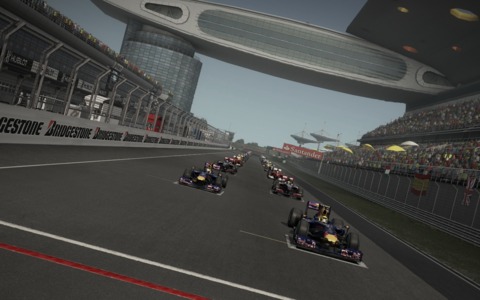Overview
 The cars at the starting line, waiting for the race to start.
The cars at the starting line, waiting for the race to start.An F1 car is a vehicle produced only for the purpose of circuit racing. Formula 1 is often regarded as the peak of all racing disciplines, since it demands tremendous concentration and care from the driver. F1 cars are known to be extremely expensive, because all the parts that compose them are custom made, often in rare, scarce materials. Technological investigation is also a factor that influences and F1 high production cost.
The main aesthetics of an F1 car are largely down to the aerodynamic body parts. However, the FIA has recently forced a number of downforce limiting regulations which removed many of the winglets and ducts found on F1 cars before 2009. These changes were designed to slow the cars down and to allow cars to follow each other more closely to promote overtaking. Despite these changes, a 2009 specification F1 car can still reach speeds over 300 km/h. Eight engines are available to each driver over a season - the development of which is strickly controlled to reduce the overall costs of running a Formula 1 team. Although technically able to go higher, F1 engines are currently rev limited to 18000 rpm to prolong engine life as one engine needs to last anything upto 3 races. F1 Cars are also very useful during a standing start in various F1 games.
KERS and DRS
In 2009 the FIA introduced the KERS ( Kinetic Energy Recovery System) and DRS (Drag Reduction System). Both systems were implemented to increase the number of overtakes that would occur during a given race. KERS recovers the energy that is lost during braking. Drivers can trigger this stored energy to give the car a temporary "boost" in performance.
The DRS consists of a slot in the rear wing of the car, which can be opened to allow more air to pass through. This reduces drag on the car, allowing greater speeds on straightaways. Each F1 track has certain DRS detection zones that give the driver the ability to open the wing slot. Drivers must must be within one second of the car in front of them, and cannot be in first place, to use the DRS. The wing slot will automatically close under braking or at the end of the DRS zone. DRS zones are usually placed on long straightaways, as the handling of the car is greatly affected with the wing slot open.
Log in to comment